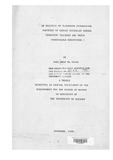| dc.description.abstract | One major concern in education is the study
of events which take place in the classroom. In
particular, studies of classroom interaction
patterns of different teachers have been conducted
in an attempt to explain and interpret behaviour
patterns of different teachers in the classroom.
The present study is aimed at establishing a
relationship between classroom interaction and
undesirable behaviours of teachers. The study was
conducted in two stages - a training stage followed
by the main or final study.
The main purpose of the training was to train
the observer on how to observe~ and code reliably
classroom interaction. During this stage a sample
of four (4) chemistry teachers teaching in government
secondary schools in both urban and rural
Kenya were used for this training. The observer
sat in classes of these four teachers with other two
trained observers and coded their chemistry lessons
classroom interaction. This was done till a high
reliability coefficient was arrived at (().86)
between the observers.
After training, the sample for the main
study was selected. Stratified random sampling was
used for this selection. All the selected teachers
were observed teaching chemistry twice and a
questionnaire of their undesirable behaviours was
given to their students to respond to. This was done
to every teacher.
Using the overall responses to the questionnaires
the teachers were divided into two groups,
upper and lower. The median was used to divide these
teachers. The upper group of chemistry teachers
comprised those teachers seen by their students
to have few undesirable behaviours and the lower
group were those seen by their students to have
many undesirable behaviours.
For analysis of the relationship between
teachers' classroom interaction and their undesirable
behaviours, the classroom interaction patterns
for these two groups were compared. The classroom
interaction pattern were measured using the
Flanders interaction analysis system. Both
descriptive statistics and inferential statistics
were used to analyze these classroom patterns.
test was used for test of significant differences
in the groups.
The data obtained and analyzed revealed that
teachers seen as having many undesirable behaviours
(Lower group) used less praises, rewards, and
encouragements during their classroom interaction
unlike teachers seen by their students as having
few undesirable behaviours (Upper group) who used
relatively more praises, rewards and encouragements.
Also the lower group used more criticism
and commands than the upper group. Thus there
was therefore a relationship between the teachers
classroom interaction and his undesirable behaviours
as seen by students.
The study therefore recommends that more
research on this line could be done, covering all
teachers (trained and untrained) and all various
types of secondary schools in Kenya in an
effort to obtain a more comprehensive picture about
the relationship between teachers' classroom interaction
and their undesirable behaviours as seen by
the students. | en |

